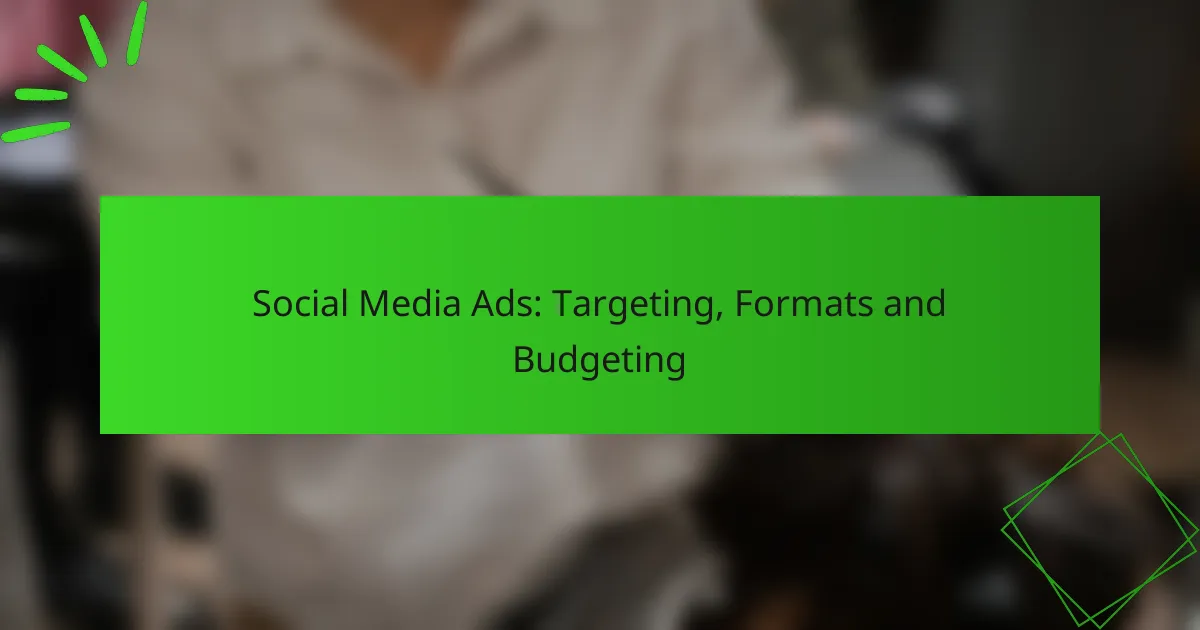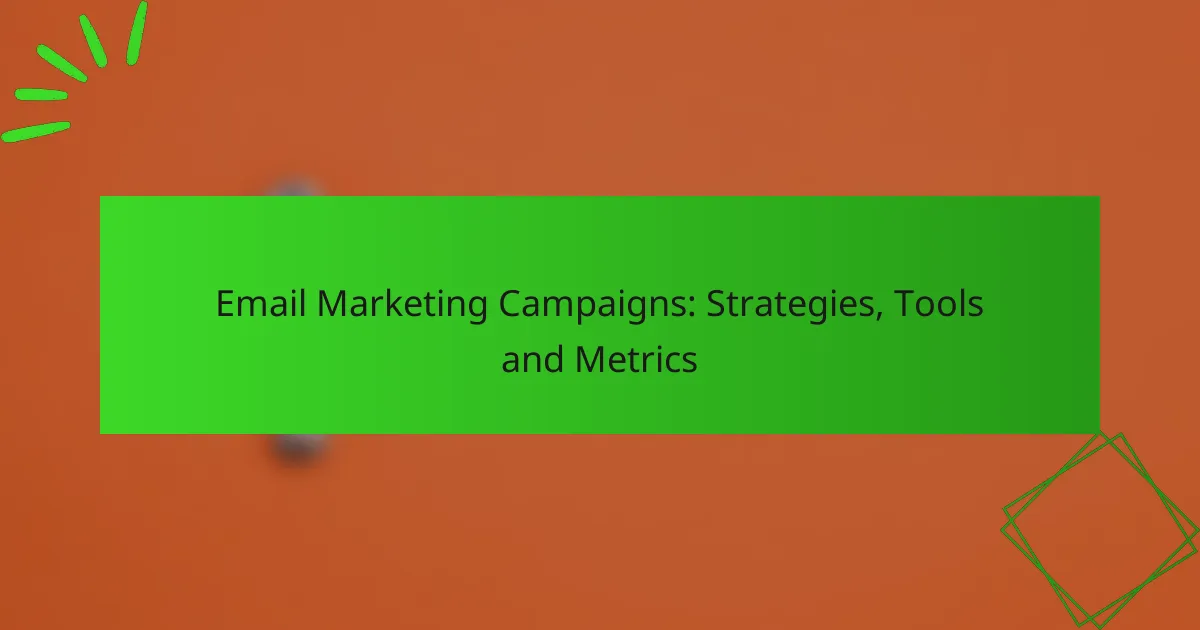Sales funnels are essential frameworks that outline the journey potential customers take from awareness to purchase. By understanding the various stages of a sales funnel, businesses can refine their marketing strategies to effectively engage prospects and enhance conversion rates. Analyzing sales funnel metrics provides valuable insights into customer behavior, enabling companies to identify improvement areas and optimize their sales processes for increased revenue.

What are the stages of a sales funnel?
The stages of a sales funnel represent the journey potential customers take from first learning about a product to making a purchase and beyond. Understanding these stages helps businesses tailor their marketing strategies to effectively guide prospects through the buying process.
Awareness stage
In the awareness stage, potential customers become aware of a problem or need and discover your product or service as a possible solution. This stage often involves broad marketing efforts such as social media campaigns, blog posts, and advertisements to attract attention.
Effective tactics include using engaging content, SEO strategies, and targeted ads to reach a wider audience. Aim to create compelling messages that resonate with your target demographic to maximize reach.
Consideration stage
During the consideration stage, prospects evaluate different solutions, including your offerings. They seek more detailed information, such as product features, pricing, and comparisons with competitors.
Provide valuable content like case studies, webinars, and detailed product descriptions to help prospects make informed decisions. Engaging with potential customers through email marketing can also nurture their interest and keep your brand top-of-mind.
Decision stage
In the decision stage, prospects are ready to make a purchase. They weigh the final details, such as pricing, discounts, and customer reviews, before committing. This is where effective sales tactics can significantly influence their choice.
Offering limited-time promotions, free trials, or money-back guarantees can encourage prospects to finalize their purchase. Clear calls-to-action and simplified checkout processes are essential to reduce friction and enhance conversion rates.
Retention stage
The retention stage focuses on keeping customers engaged after their initial purchase. Satisfied customers are more likely to return for repeat purchases and can become loyal advocates for your brand.
Implement strategies such as personalized follow-up emails, loyalty programs, and exceptional customer service to enhance customer satisfaction. Regularly soliciting feedback can also help you improve your offerings and address any concerns promptly.
Advocacy stage
In the advocacy stage, loyal customers become brand advocates, promoting your products through word-of-mouth and social sharing. This stage is crucial for generating new leads and enhancing your brand’s reputation.
Encourage advocacy by creating referral programs, engaging with customers on social media, and showcasing user-generated content. Recognizing and rewarding loyal customers can further strengthen their commitment and willingness to promote your brand.
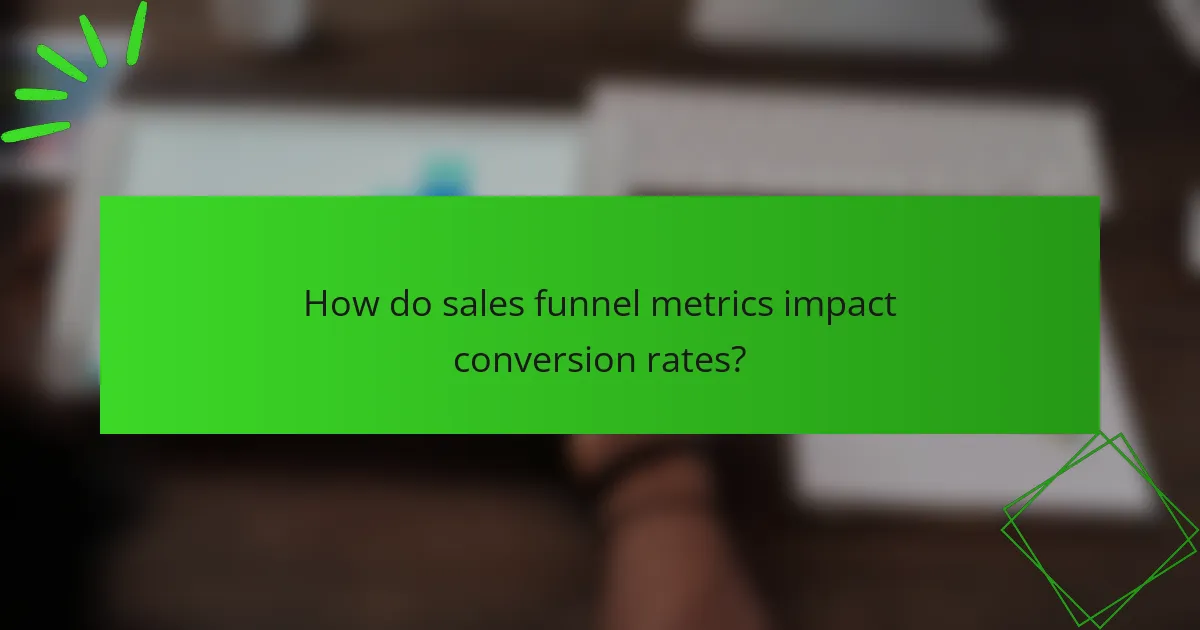
How do sales funnel metrics impact conversion rates?
Sales funnel metrics directly influence conversion rates by providing insights into customer behavior and identifying areas for improvement. By analyzing these metrics, businesses can optimize their sales processes, leading to higher conversion rates and increased revenue.
Key performance indicators
Key performance indicators (KPIs) are essential for measuring the effectiveness of each stage in the sales funnel. Common KPIs include lead conversion rates, average deal size, and sales cycle length. Tracking these indicators helps businesses understand where they excel and where they need to focus their efforts.
For example, if the lead conversion rate is low, it may indicate issues in the initial engagement stage, prompting a review of marketing strategies or lead qualification processes.
Conversion rate optimization
Conversion rate optimization (CRO) involves enhancing the sales funnel to increase the percentage of leads that become customers. This can be achieved through A/B testing, improving landing page designs, and refining calls to action. Regularly analyzing user behavior can reveal bottlenecks that hinder conversions.
Implementing small changes, such as simplifying forms or offering incentives, can significantly boost conversion rates. A typical range for conversion rates in e-commerce is around 1% to 3%, but effective CRO strategies can push these numbers higher.
Customer acquisition cost
Customer acquisition cost (CAC) measures the total cost of acquiring a new customer, including marketing and sales expenses. Understanding CAC is crucial for evaluating the efficiency of the sales funnel. A high CAC can indicate that the funnel is not optimized, leading to wasted resources.
To manage CAC, businesses should analyze their marketing spend and focus on channels that yield the best return. For instance, if social media ads generate high-quality leads at a lower cost than traditional advertising, reallocating budget towards those channels can improve overall efficiency.
Return on investment
Return on investment (ROI) assesses the profitability of investments made in the sales funnel. A positive ROI indicates that the revenue generated from customers exceeds the costs incurred in acquiring them. Monitoring ROI helps businesses make informed decisions about where to allocate resources for maximum impact.
To calculate ROI, divide the net profit from sales by the total cost of the sales funnel activities. A common benchmark is to aim for an ROI of at least 300%, meaning that for every dollar spent, three dollars are earned back. Regularly reviewing ROI can guide strategic adjustments to improve overall sales performance.
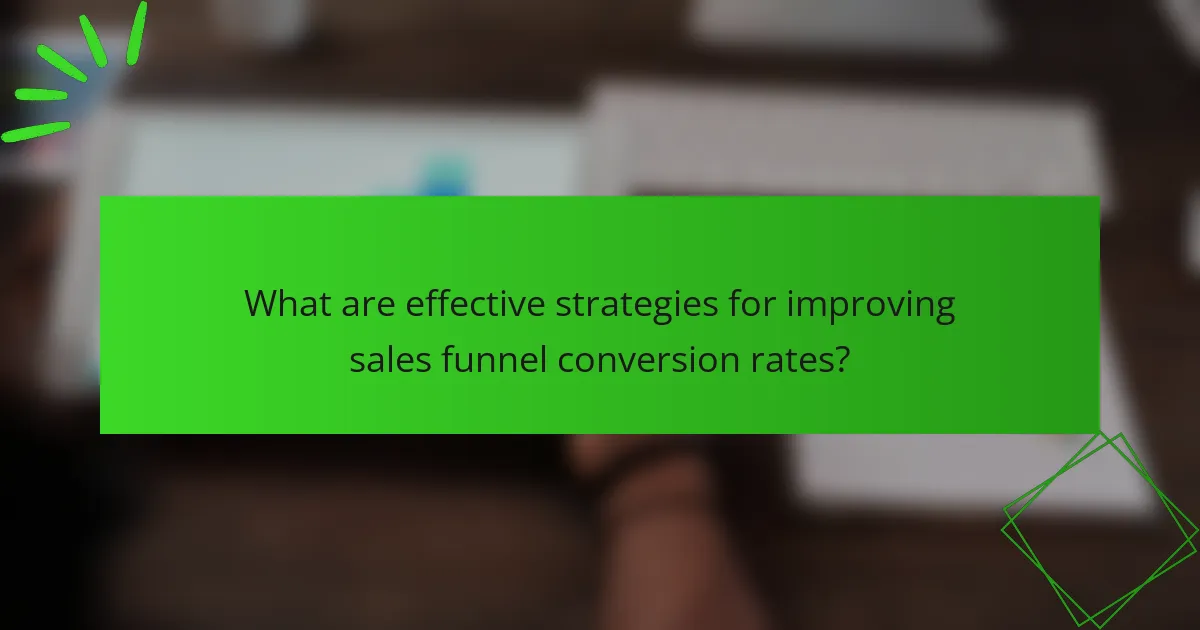
What are effective strategies for improving sales funnel conversion rates?
Improving sales funnel conversion rates involves implementing targeted strategies that enhance user engagement and streamline the purchasing process. Key approaches include personalization, lead nurturing, A/B testing, and integrating content marketing effectively.
Personalization techniques
Personalization techniques tailor the user experience based on individual preferences and behaviors, significantly boosting conversion rates. Utilizing data analytics, businesses can segment their audience and deliver customized messages, offers, and product recommendations.
For example, an e-commerce site might show different product suggestions based on past purchases or browsing history. This targeted approach can increase user satisfaction and encourage repeat visits.
Lead nurturing tactics
Lead nurturing tactics focus on building relationships with potential customers throughout their journey in the sales funnel. Effective methods include sending personalized emails, providing valuable content, and engaging through social media to keep leads informed and interested.
Consider implementing a drip email campaign that delivers relevant information over time, gradually guiding leads toward a purchase decision. This approach helps maintain engagement and can lead to higher conversion rates.
A/B testing methods
A/B testing methods involve comparing two versions of a webpage or marketing material to determine which performs better in terms of conversion rates. This systematic approach allows businesses to make data-driven decisions based on user behavior.
For instance, testing different call-to-action buttons or landing page layouts can reveal which design resonates more with your audience. Aim for a sample size that allows for statistically significant results, typically in the low hundreds or thousands, depending on your traffic.
Content marketing integration
Content marketing integration enhances the sales funnel by providing valuable information that addresses customer pain points and builds trust. High-quality content, such as blog posts, videos, and infographics, can attract and engage potential customers at various stages of their journey.
Incorporate content that aligns with your audience’s needs, such as how-to guides or case studies, to nurture leads and encourage them to move further down the funnel. Regularly updating your content can keep it relevant and effective in driving conversions.
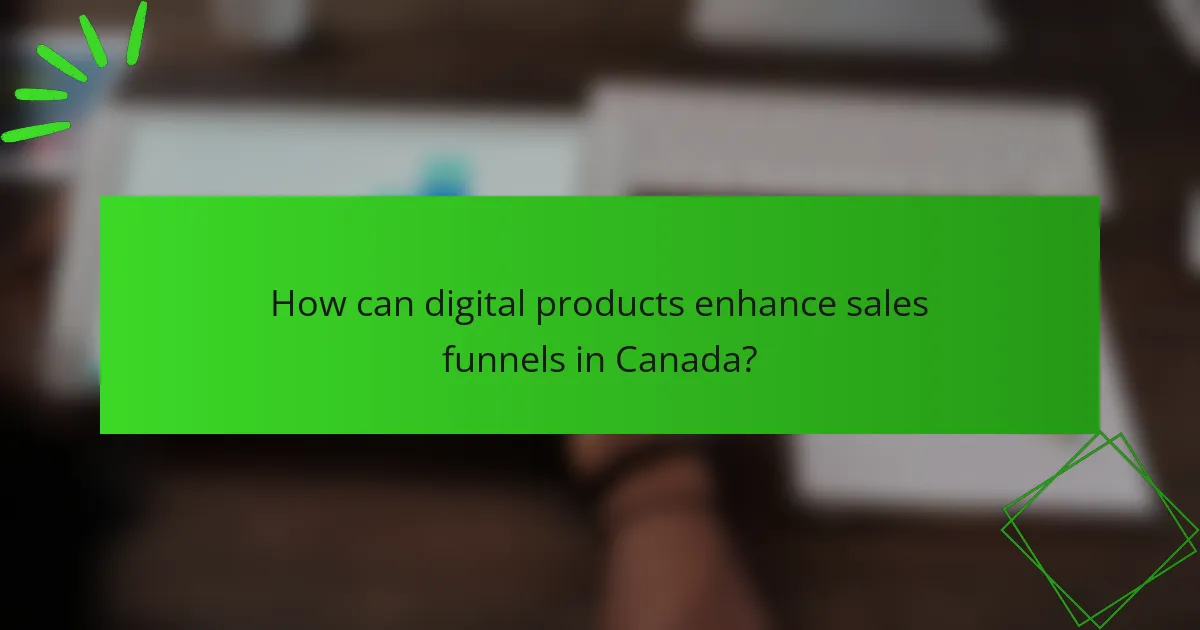
How can digital products enhance sales funnels in Canada?
Digital products can significantly enhance sales funnels in Canada by streamlining customer interactions and improving conversion rates. By integrating digital solutions, businesses can better track customer behavior, personalize marketing efforts, and ultimately drive more sales.
Utilizing CRM software
CRM software is essential for managing customer relationships and tracking interactions throughout the sales funnel. In Canada, popular CRM platforms like Salesforce and HubSpot allow businesses to segment leads, automate follow-ups, and analyze customer data effectively.
To maximize the benefits of CRM, ensure that your team is trained on its features and regularly updates customer information. This practice helps maintain accurate records and improves the overall sales process.
Leveraging email marketing
Email marketing is a powerful tool for nurturing leads and converting them into customers. In Canada, businesses can use platforms like Mailchimp or Constant Contact to create targeted campaigns that resonate with specific customer segments.
It’s crucial to personalize email content and include clear calls to action. A/B testing subject lines and sending times can also help optimize open and click-through rates, leading to higher conversions.
Implementing analytics tools
Analytics tools provide insights into customer behavior and sales funnel performance. In Canada, tools like Google Analytics and Hotjar can help businesses track key metrics such as conversion rates and user engagement.
Regularly review analytics data to identify bottlenecks in the sales funnel and make informed adjustments. Setting up goals in your analytics platform can also help measure the effectiveness of your marketing strategies and improve overall performance.

What prerequisites should be considered for optimizing a sales funnel?
To optimize a sales funnel effectively, businesses must consider their target audience, set clear goals, and map the customer journey. These prerequisites lay the groundwork for understanding how to attract, engage, and convert potential customers.
Understanding target audience
Identifying the target audience is crucial for sales funnel optimization. This involves researching demographics, preferences, and behaviors to tailor marketing strategies that resonate with potential customers. Utilize surveys, social media insights, and analytics tools to gather relevant data.
Once the target audience is defined, create buyer personas that encapsulate their characteristics. This helps in crafting personalized messages and offers that can significantly improve engagement rates throughout the funnel.
Defining clear goals
Setting clear goals is essential for measuring the success of a sales funnel. Goals should be specific, measurable, achievable, relevant, and time-bound (SMART). For instance, a goal could be to increase conversion rates by a certain percentage within a quarter.
Regularly review and adjust these goals based on performance metrics. This ensures that the sales funnel remains aligned with business objectives and market conditions, allowing for timely adjustments to strategies.
Mapping customer journey
Mapping the customer journey involves outlining the steps a potential customer takes from awareness to purchase. This process helps in identifying touchpoints where customers interact with the brand, allowing for targeted improvements in each stage of the funnel.
Consider using tools like customer journey mapping software to visualize this process. Highlight key interactions and pain points, and develop strategies to enhance the customer experience, which can lead to higher conversion rates.








